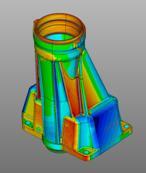Geometry Determination
Actual/nominal comparison Determination of measurement features Wall thickness measurement Evaluation of defect sizes
In recent years the methodologies of metrology and dimensional measurement were expanded by introducing the novel technology of industrial 3D X-ray computed tomography (3DCT). 3DCT is an established method for visualization and for non-destructive-testing (NDT) of industrial components and has recently gained importance in the area of dimensional measurement for industrial components. 3DCT provides full geometric information of a specimen including inner or hidden structures. A single scan non-destructively characterizes a specimen and detects material defects and geometrical irregularities of the manufacturing process. Furthermore, the typical limitations of tactile and optical coordinate measurement technology can be avoided (e.g., problems with deformable surfaces, reflecting glass probes).
Advantages
The advantages of CT for dimensional measurement are mainly found in the following areas:
- The complete scan of a specimen takes about 60-90 min, independent of the specimen geometry.
- 3DCT also evaluates hidden and internal structures without destroying the specimen. Conventional methods are limited to measuring accessible and visible parts of the specimen.
- 3DCT is a non-touching method, also deformable and flexible components may be measured.
- The specimen does not have to have a special orientation while scanning, which reduces the overall measurement time of routine tests.
Opportunities
For geometric evaluation of CT data 4 different methods are available:
- Actual/nominal comparison: Actual/nominal comparison is used to compare dimensional measurement data with reference geometry data. Deviations are color-coded on the surface of the reference model.
- Determination of measurement features: Evaluation of single measurement features, e.g., distances, diameters etc. using a coordinate measurement tools.
- Wall thickness measurement: Evaluation of wall thicknesses: Using a special software module, wall thicknesses may be evaluated using color-coding.
- Automatic evaluation of parameter sets and inspection protocols. The measurement protocol contains all interesting measurement features and the deviation to the nominal geometry.
